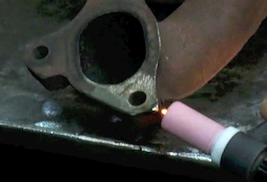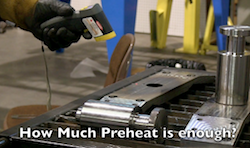Tig Welding Carbon Steel and Low Alloy Steels
Tig welding carbon steel is fairly simple. Things start to get more difficult as carbon content increases.
This Video is on Welding Low alloy high strength steel.
This particular low alloy steel has a carbon equivalent of around .60%
What is a "carbon equivalent"?
Well...its a very long formula that takes into account other elements like manganese, silicon, chromium, molybdenum,vanadium, nickel, and copper have a combined effect on a steels tendency to harden upon quick cooling from an elevated temperature.
click here for part2
A Carbon equivalent formula looks something like this:
CE = C + ((Mn + Si)/6) + ((Cr + Mo + V)/5) + ((Ni + Cu)/15)
A good example of a familiar material is 4130 chromoly.
4130 chromoly has about .30% carbon but when you plug in all its other elements in its chemical composition, the carbon equivalent is more like .60%.....thats a big difference and also the reason why 4130 chromoly over .125" thick requires a preheat to slow the cooling rate and prevent hardening.
The Low alloy carbon steel I am welding in this video has a carbon content of around .30% but the carbon equivalent is more like .60%
That calls for a preheat of 500F.
The primary reason for preheat is to slow cooling.
But 2 side benefits are:
- removes moisture and hydrogen
- reduces effect of thermal shock
In this video, I use cast iron as an extreme example of why preheat is necessary on carbon steel where carbon content or carbon equivalent is high enough to cause hardening.
Did you notice how I used a tig torch to puddle a corner of the manifold?

I have used this quick down and dirty test many times to check the hardenability of an unknown steel. if you puddle a corner and a file will still easily cut the puddled area, carbon content is pretty low and problems are unlikely.
If a file slides over the puddled area like it was made of glass, you know problems are likely unless you preheat and take other precautions too.

Undermatching filler metal for welding low alloy carbon steel?
You cant always undermatch filler metal because filler metal is often specified on a blueprint or welding code.
But sometimes, you are the one choosing filler metal.
When I can, and when it makes sense, I often under match filler metal.
Undermatching means using a filler metal that is one or two grades lower than the base metal.
Its really pretty common.
Some examples:
- 4130 chromoly tubing for aircraft is often welded with plain er70s-2 mild steel tig rod.
- 6AL4V titanium is often welded with comercially pure titanium filler rod.
- 6061 aluminum is often welded with 4043 (hardly ever welded with 6061 rod)
Often times, the design of a weldment can provide more strength than any certain filler metal.
In the case of the welded joint in this video, the pin is a press fit, gets welded on both sides, and the weld is not directly stressed in tension.
see more videos on tig welding carbon steel














